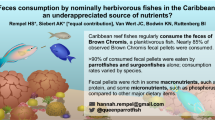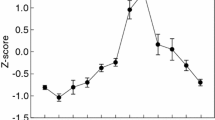Abstract.
The morphological and physiological mechanisms by which marine herbivores assimilate energy and nutrients from primary producers and transfer them to higher trophic levels of reef ecosystems are poorly understood. Two wide-ranging Caribbean fishes, the dusky damselfish, Stegastes dorsopunicans, and the threespot damselfish, S. planifrons, defend territories on patch reefs in the Archipelago de San Blas, Republic of Panama. We examined how relative intestine length and retention time influence digestion and absorption of energy and nutrients in these fishes. The dusky damselfish has a relative intestine length (RIL=intestine length/standard length) of 1.2 and a Zihler index {ZI=intestine length (mm)/10[mass(g)1/3]} of 3.4. These values are significantly lower (P RIL=P ZI<0.0001) than those for the threespot damselfish (3.0 and 8.2, respectively). Both RIL and ZI for both species fall well below previously published values for other herbivorous pomacentrids, and may reflect their primary food resource at San Blas (diatoms). Energy-rich diatoms may be easier to digest than refractory macroalgae characteristic of diets of many herbivorous fishes (RIL range: 2–20). Despite differences in RIL and ZI between these two species, gut retention time is the same (P>0.05) for both dusky (6.6 h) and threespot damselfish (6.5 h). Thus, food travels the length of the threespot damselfish intestine ~2.5 times faster than it does in the dusky damselfish intestine. Levels of protein, carbohydrate, and lipid are significantly (0.003<P<0.030) higher in the feces of dusky damselfish than in the feces of threespot damselfish, when both species were fed a natural diet of benthic diatoms collected from damselfish territories. This indicates threespot damselfish have a greater nutrient-specific and total assimilation efficiency than do dusky damselfish. Furthermore, when fed an artificial pellet diet, protein absorption efficiency differed significantly (P=0.014) between species; threespot damselfish absorbed 98.3% of dietary protein, whereas dusky damselfish absorbed 96.4% of dietary protein.
Similar content being viewed by others
Author information
Authors and Affiliations
Additional information
Electronic Publication
Rights and permissions
About this article
Cite this article
Cleveland, .A., Montgomery, .W. Gut characteristics and assimilation efficiencies in two species of herbivorous damselfishes (Pomacentridae: Stegastes dorsopunicans and S. planifrons). Marine Biology 142, 35–44 (2003). https://doi.org/10.1007/s00227-002-0916-4
Received:
Accepted:
Issue Date:
DOI: https://doi.org/10.1007/s00227-002-0916-4




